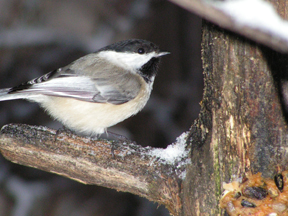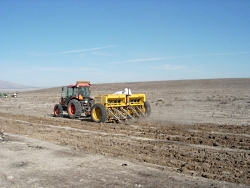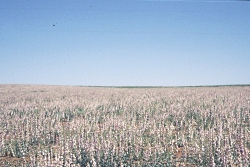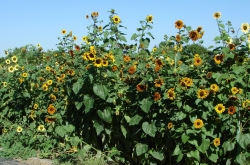
A Black-capped Chickadee
Bridgerland Audubon Society
In the icy, short days of winter, you may think that Nature itself has curled up to hibernate. Our gardens are drab and deciduous trees are stripped down to bare limbs and twigs. Many songbirds have bid us farewell and flown south. In truth, what remains to be seen and heard of nature here in winter is more subtle and less boisterous. Now is the time to learn calls and songs of birds that reside here year-round, to hear them in solo performances, before the confusing springtime symphonies of birdsong.
This first bird calls its own name [sound: “Chick-a-dee-dee-dee” #9 Songbirds of the Rocky Mountain Foothills]. Black-capped Chickadees take sunflower seeds one at a time from our feeders. When out snowshoeing or skiing in our forests, inquisitive chickadees are welcome companions. They bring joy to a wintry day.
Frequently, a winter chickadee flock includes other birds. [Sound: “annk-annk” #48 Songbirds of Yellowstone] This bird sounds like a child’s squeak toy, but that nasal call belongs to the Red-breasted Nuthatch. Look for this chunky small bird at your suet feeder, or cruising up and down tree trunks in its search for insects.
We also have a minimalist in our winter bird repertoire [Sound: “tew” #62 Songbirds of Yellowstone]. That single note belongs to the Townsend’s Solitaire, which looks like a lean robin, colored the somber gray of an overcast sky. In winter, solitaires dine predominately on juniper berries. Their call stakes out their winter feeding territory. They are regulars at our heated birdbath, perhaps washing down all those puckery berries. If you are lucky, you may also hear their musical warbling, which is more common in warmer months. (Kevin Colver: Songbirds of Yellowstone)
You often hear chickadees, nuthatches and solitaires before you see them, as their plumage is neither colorful nor splashy. If you notice these calls on a winter’s day, it is because you are quiet and focused on the nature around you, leaving civilization’s hubbub behind. Thank-you to Kevin Colver for his wonderful bird recordings.
Credits:
Bird Sounds: Courtesy and Copyright 2008 Dr. Kevin Colver, Songbirds of the Rocky Mountain Foothills and Songbirds of Yellowstone and the High Rockies https://wildstore.wildsanctuary.com/collections/special-collections
Text: Jim Cane, Bridgerland Audubon Society https://www.bridgerlandaudubon.org
Additional Reading:
Black-capped Chickadee, All About Birds, Cornell Lab of Ornithology, https://www.birds.cornell.edu/AllAboutBirds/BirdGuide/Black-capped_Chickadee.html
Red-breasted Nuthatch, All About Birds, Cornell Lab of Ornithology, https://www.birds.cornell.edu/AllAboutBirds/BirdGuide/Red-breasted_Nuthatch.html
Townsend’s Solitaire, All About Birds, Cornell Lab of Ornithology, https://www.birds.cornell.edu/AllAboutBirds/BirdGuide/Townsends_Solitaire.html









